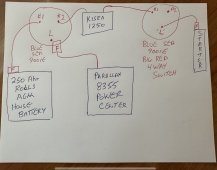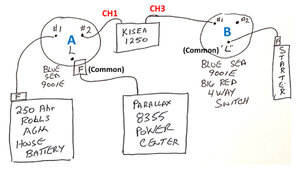steven1955
New Member
I've seen too many FDLFBR (Friends don't let friends by Renogy) comments.
The application is the updating of our 1975 FMC 2900R motorhome to lithium with (hopefully) near term future solar. 270-ish Ah of cooked AGM batteries are being replaced with 400 Ah of LiFePO4 batteries.
On paper the Renogy DCC50S wins due to automatic voltage sensing, an ability to top off the starter battery when the house batteries are fully charged, and Bluetooth communication via their BT-2 Bluetooth module.
The Kisae DMT1250 has a higher solar input voltage and, for those FDLFBR commenters, it's not a Renogy.
What would you buy?
Stirling also has a DC to DC charger with MPPT solar capability, but it's pretty pricey and limited to 30 amps. Victron is also limited to 30 amps and would require two boxes as they don't currently offer a combined DC to DC/MPPT solar charger.
The application is the updating of our 1975 FMC 2900R motorhome to lithium with (hopefully) near term future solar. 270-ish Ah of cooked AGM batteries are being replaced with 400 Ah of LiFePO4 batteries.
On paper the Renogy DCC50S wins due to automatic voltage sensing, an ability to top off the starter battery when the house batteries are fully charged, and Bluetooth communication via their BT-2 Bluetooth module.
The Kisae DMT1250 has a higher solar input voltage and, for those FDLFBR commenters, it's not a Renogy.
What would you buy?
Stirling also has a DC to DC charger with MPPT solar capability, but it's pretty pricey and limited to 30 amps. Victron is also limited to 30 amps and would require two boxes as they don't currently offer a combined DC to DC/MPPT solar charger.




